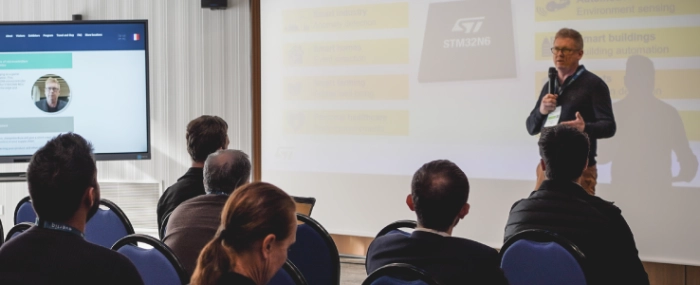
ST's response to the global race for AI
In recent years, the electronics industry has been marked by tension caused by economic, defence, and technological turmoil. Many countries and companies view artificial intelligence as both a major opportunity and a potential game changer in the ongoing race. The challenges surrounding AI were a key focus at the recent Evertiq Expo in Sophia Antipolis — a topic that drew strong interest, as reflected in the high attendance at the presentation by Edwin Hilkens of STMicroelectronics.
As connected devices spread across industrial, automotive, medical, and consumer applications, embedded systems are increasingly expected to make instant decisions based on real-world data — all while meeting constraints such as ultra-low latency, data privacy, and low power consumption.
“The explosion of smart devices is pushing AI inference closer to the source of data,” said Edwin Hilkens on the Evertiq stage. “This shift helps reduce latency, improve energy efficiency, and keep sensitive data local.”
However, running AI models on small, low-power devices remains a significant technical hurdle. Traditional AI typically requires computing power only found in larger processors or cloud infrastructures.
The rise of AI-capable microcontrollers
This is where a new class of microcontrollers enters the picture — designed specifically for on-device AI processing. They combine the traditional strengths of MCUs (simplicity, low power, small form factor) with the ability to run real-time AI workloads such as image recognition or pattern analysis.
STMicroelectronics’ STM32N6 series follows this trend, introducing a neural processing unit directly within the MCU architecture. More importantly, it reflects a broader shift in how we think about embedded intelligence.
“The goal is to offer a microprocessor-class user experience — without the complexity,” Hilkens noted.
Real-world use cases that show the power of local AI
During the presentation, several practical examples illustrated the benefits of running AI at the edge. These included people detection, multi-pose estimation, and gesture recognition — each delivering strong results without relying on external processing.
For example:
- People detection: ideal for smart doorbells or occupancy-aware systems.
- Pose estimation: used in healthcare monitoring, fall detection, or behavioural analysis.
- Hand tracking: ideal for contactless interfaces in appliances or industrial controls.
Smarter systems start at the source
Edge AI isn’t just a tech trend — it represents a fundamental shift in how electronic systems are built and deployed. Instead of sending raw data to the cloud, devices are being empowered to understand and act locally, enhancing responsiveness, privacy, and adaptability.
This approach allows designers to build autonomous, efficient, and context-aware devices that can respond in real-time to their environment — whether in a factory, a hospital, or a smart home.
If you’re interested in exploring more about electronics and real-world applications like these, don’t miss the next Evertiq Expo on March 5, 2026, in Sophia Antipolis — a great opportunity to connect with industry experts and discover the latest innovations.

